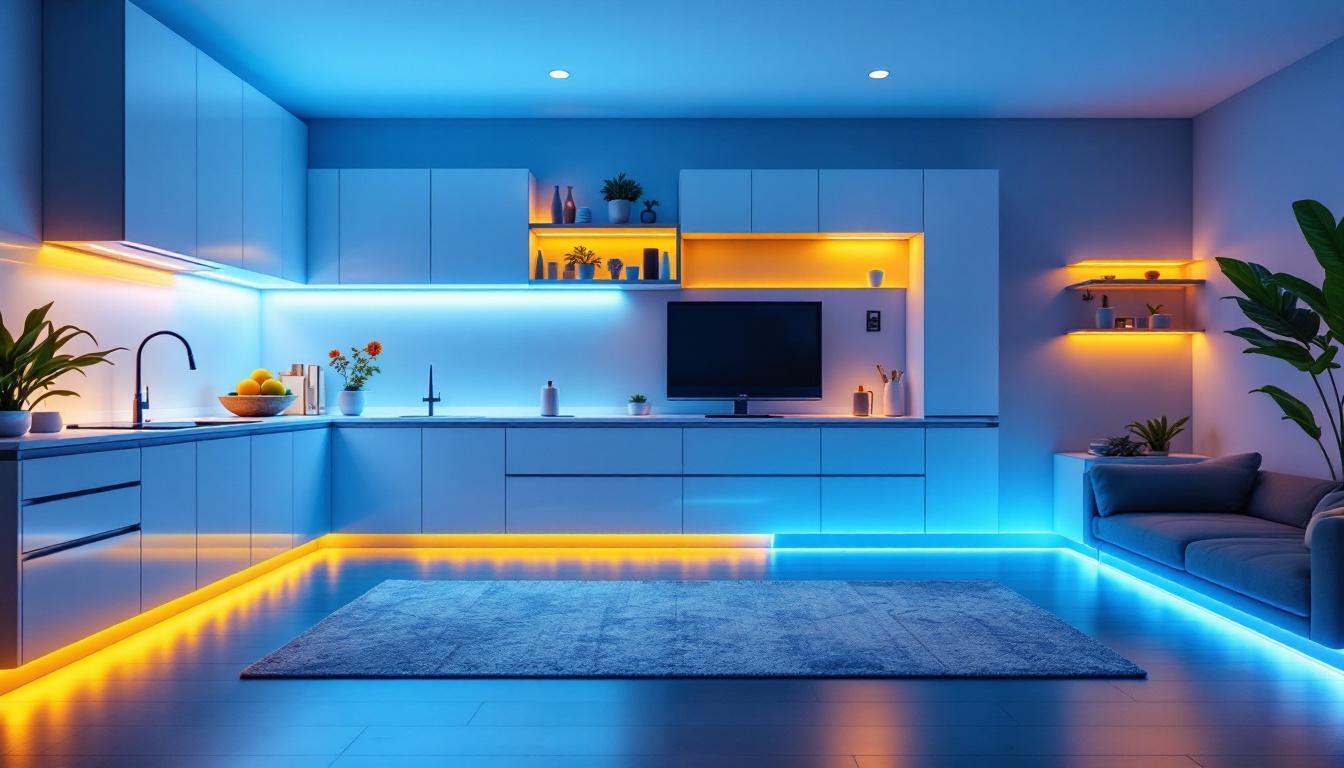In the realm of construction and renovation, proper lighting is paramount. For lighting contractors, selecting the right string work lights can significantly impact the quality of work and safety on job sites. This guide aims to provide insights into the essential factors to consider when choosing string work lights, ensuring that contractors can make informed decisions that enhance their productivity and efficiency.
String work lights are versatile lighting solutions designed for temporary use in various work environments. These lights typically consist of a series of bulbs connected by a flexible cord, allowing for easy setup and adjustment. They are particularly useful in large spaces where permanent lighting fixtures are not feasible.
The primary function of string work lights is to illuminate work areas, ensuring that tasks can be performed safely and efficiently, even in low-light conditions. Their portability and ease of installation make them a preferred choice for many contractors. Whether you’re working on a construction site, hosting an outdoor event, or tackling a home improvement project, string work lights provide the necessary illumination to keep the workspace bright and visible.
Moreover, the adaptability of string work lights extends beyond just construction sites; they can also be used in garages, workshops, and even for festive occasions. Their ability to be easily hung or draped allows for creative lighting solutions that can enhance both functionality and ambiance in any setting.
When selecting string work lights, it is crucial to understand the different types available on the market. The most common varieties include incandescent, LED, and fluorescent string lights. Each type has its unique characteristics, advantages, and disadvantages.
Incandescent string lights are traditional options that provide warm light but are less energy-efficient and have a shorter lifespan compared to their LED counterparts. These lights can create a cozy atmosphere, making them suitable for events where a softer glow is desired. LED string lights, on the other hand, are known for their durability, energy efficiency, and longer operational life, making them a popular choice for contractors. They emit a bright, clear light that can significantly enhance visibility in work areas, reducing the risk of accidents. Fluorescent string lights offer a balance between the two but may not be as widely used in temporary setups. They can be effective for illuminating larger spaces due to their broad light distribution, though they might not provide the same warmth as incandescent options.
When choosing string work lights, several key features should be taken into account. These include brightness, durability, length of the cord, and the number of bulbs. Brightness is typically measured in lumens; higher lumens indicate brighter lights, which are essential for detailed work.
Durability is another critical factor, especially for construction sites where equipment may be exposed to harsh conditions. Look for string lights with rugged, weather-resistant designs to ensure they withstand the rigors of the job. Additionally, consider the length of the cord and the spacing between bulbs to ensure adequate coverage in the work area. Some models come with adjustable hooks or clips, allowing for versatile mounting options that can accommodate various environments. Furthermore, it’s worth noting that many modern string work lights are equipped with features such as dimming capabilities or smart technology, enabling users to customize the lighting according to their specific needs. This level of flexibility can be particularly beneficial in settings where lighting requirements may change throughout the day or during different tasks.
Safety is a paramount concern for lighting contractors. String work lights must not only provide adequate illumination but also meet safety standards to prevent accidents. Understanding the safety features of string lights can help contractors avoid potential hazards.
One of the most critical safety aspects to consider is electrical safety. Ensure that the string lights are rated for outdoor use if they will be exposed to the elements. Look for lights that have a grounded plug and are equipped with circuit breakers to prevent overloads.
Additionally, inspect the cords for any signs of wear or damage before each use. Using extension cords that are rated for the total wattage of the lights is also essential to prevent overheating and potential fire hazards. It’s advisable to use heavy-duty extension cords designed for outdoor use, as these are typically more resistant to wear and tear from environmental factors such as moisture and UV exposure.
Proper placement of string work lights is vital for maximizing visibility and minimizing shadows. Contractors should strategically position lights to cover the entire work area, ensuring that all tasks can be performed safely.
Consider using multiple strings of lights to create a well-lit environment, especially in larger spaces. This approach not only enhances visibility but also reduces the risk of accidents caused by poor lighting. Furthermore, employing adjustable mounting options can allow for flexibility in directing light where it is most needed, accommodating changes in the workspace or task requirements. Utilizing diffusers or frosted bulbs can also help to soften the light, reducing glare and eye strain for workers who may be in the area for extended periods.
In today’s environmentally conscious world, energy efficiency is a significant consideration for contractors. Choosing energy-efficient string work lights can lead to substantial cost savings over time. As awareness of environmental issues grows, many contractors are also looking to enhance their reputation by adopting sustainable practices, making energy efficiency not just a financial decision but also a strategic one.
LED string lights are the most energy-efficient option available, consuming significantly less power than incandescent or fluorescent alternatives. This efficiency translates to lower electricity bills, making LED lights a cost-effective choice for long-term projects. Furthermore, LED technology has advanced rapidly, offering a variety of color temperatures and brightness levels that can suit any job site’s needs, from warm white for a cozy atmosphere to bright daylight for optimal visibility.
Contractors should also consider the initial investment versus long-term savings. While LED lights may have a higher upfront cost, their longevity and reduced energy consumption often make them the more economical choice in the long run. It’s worth noting that many LED lights also have a lifespan of up to 25,000 hours or more, which means fewer replacements and less waste, aligning with sustainable construction practices.
When budgeting for string work lights, it is essential to factor in not only the purchase price but also the potential costs associated with energy consumption and maintenance. Investing in high-quality lights may result in higher initial costs but can lead to reduced replacement and energy costs over time. Additionally, the durability of LED string lights means they can withstand harsh conditions, reducing the likelihood of damage and the need for frequent replacements.
Additionally, consider the availability of replacement parts and warranties offered by manufacturers. A good warranty can provide peace of mind and protect your investment in case of defects or failures. Some manufacturers even offer extended service plans that cover not just the lights but also the associated equipment, ensuring that contractors can maintain their work sites without unexpected expenses. Moreover, researching energy rebates or incentives available for using energy-efficient products can further offset initial costs, making it an even more attractive investment for contractors aiming to optimize their budgets.
The market is flooded with various brands of string work lights, each claiming to offer the best features and performance. Selecting a reputable brand can significantly impact the quality and reliability of the lights.
Before making a purchase, contractors should conduct thorough research on different brands. Look for reviews and testimonials from other contractors to gauge the performance and reliability of the lights. Brands with a strong reputation for quality and customer service are often more trustworthy.
Additionally, consider the availability of customer support and warranty services. A brand that stands behind its products is more likely to provide assistance in case of any issues that may arise.
Whenever possible, testing string work lights before purchasing can provide valuable insights into their performance. Many suppliers offer demo units or rental options, allowing contractors to evaluate the lights in real-world conditions.
Reading product reviews and comparisons can also help contractors make informed decisions. Look for reviews that highlight specific features, durability, and overall satisfaction from other users.
Proper maintenance of string work lights is crucial to ensure their longevity and performance. Regular care can prevent malfunctions and extend the life of the lights, ultimately saving contractors time and money.
Contractors should conduct regular inspections of string work lights before and after each use. Check for any signs of wear, frayed cords, or damaged bulbs. Addressing these issues promptly can prevent accidents and costly replacements.
Cleaning the lights and cords regularly can also enhance their performance. Dust and debris can accumulate over time, affecting brightness and efficiency. Using a soft cloth to wipe down the bulbs and cords can help maintain optimal performance.
Storage is another critical aspect of maintaining string work lights. When not in use, lights should be stored in a cool, dry place to prevent damage from moisture or extreme temperatures. Properly coiling the cords can prevent kinks and tangles, ensuring that the lights are ready for use when needed.
Consider using storage bins or cases designed specifically for string lights to keep them organized and protected. This practice not only prolongs the life of the lights but also makes setup easier on future job sites.
Selecting the right string work lights is an essential task for lighting contractors. By understanding the different types available, considering safety and energy efficiency, and choosing reputable brands, contractors can ensure they have the best lighting solutions for their projects.
Regular maintenance and proper care will further enhance the performance and longevity of string work lights, making them a valuable asset on any job site. With the right approach, contractors can illuminate their workspaces effectively, leading to safer and more productive environments.
Ready to elevate your lighting game? Look no further than LumenWholesale for a comprehensive range of top-quality, spec-grade string work lights. Our commitment to providing contractors with superior lighting products at unbeatable wholesale prices means you can light up your job sites without breaking the bank. With our hassle-free bulk buying options and free shipping, you get the best value without any hidden fees. Don’t compromise on quality or affordability. Experience the difference with LumenWholesale and make your next project shine. Wholesale Lighting at the Best Value.

Discover the best places to buy LED strips with expert insights from lighting contractors.

Discover essential information about light bulb bases that every lighting contractor needs to know.

Discover expert tips on funky pendant lamps for lighting contractors, boosting design appeal and client satisfaction.

Discover how pulling machines are revolutionizing the lighting industry by enhancing efficiency, reducing labor costs, and ensuring precision in installations.